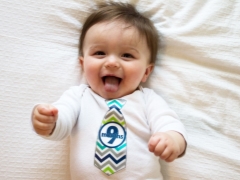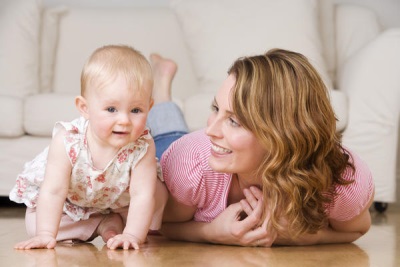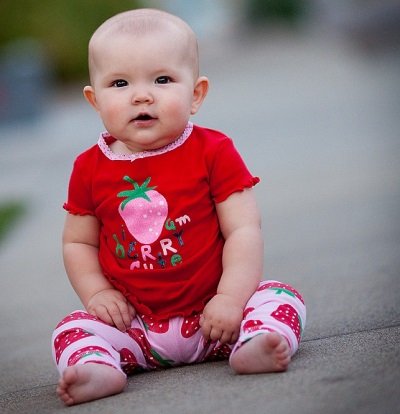Child development at 9 months
A nine-month-old child can no longer be called helpless. The crumb moves independently around the room, expresses his attitude to various events, actively communicates with his parents. What did the infant learn by 9 months of age, how should parents determine whether it is developing normally and how to help in the future development?
Physiological changes
- The body of the baby is actively preparing to walk. Strengthens the muscles of the shoulders and hips, as well as the ligamentous apparatus, develops neuromuscular coordination.
- The sense organs of the child are already well developed. The toddler has improved auditory perception, so now the child can not only hear sounds from the next room, but also compare what he heard with his knowledge. For example, having heard the sounds of pots and plates, the baby will understand that lunch is coming soon.
- The emotional sphere is also actively developing. - The crumb with its appearance shows such emotions as joy, chagrin, pleasure, resentment and others.
- Many 9-month-old babies start teething second incisors. First, they appear on the upper jaw, and a little later - on the lower jaw. At the same time, the baby’s jaws develop, so the crumbs constantly need to offer something to chew.
Physical development
During the ninth month of life, the baby gains about 500 grams, its growth is extended by 1.5 centimeters, and the circumference of the head and chest become more by 0.5-1 centimeter.
All parents understand that children develop according to their individual schedule, but to determine whether the rate of development of the crumbs is normal and whether there are any deviations that should alert, physicians are guided by average data of physical indicators for children of the same age. Also for each age there are boundary indicators - their excess should be a reason for examining a child. The main parameters of the physical development of children of 9 months, we have collected in this table:
Indicator | Average value of 9 months | Boys in 9-10 months | Girls 9-10 months |
Weight | 8200-8900 g | 7100-11000 g | 6500-10500 g |
Growth | 70.1-72 cm | 67.5-76.5 cm | 65.3-75 cm |
Head circumference | 43.8-45 cm | 42.5-47.5 cm | 41.2-46.5 cm |
Chest circumference | 46.6-47.2 cm | 44.4-50.8 cm | 44.5-49.3 cm |
You can have a massage, the technique of which in the video is shown by Nikolay Nikonov - the leading doctor and massage therapist in Russia.
What baby can?
- The child moves a lot and with pleasure consolidates the skills that he has already acquired. Baby crawls quickly in different directions and does it mostly on all fours. Also, the baby easily rises on its legs, clutching at something durable, and can even step over with its feet, holding onto the support and taking added steps.
- When the child is lying, he can sit on his own, and when he sits, lie down. Also, the baby already knows how to sit and from a standing position. Some children at this age try to stand on their own and even take the first steps without support.
- The nine-month peasant deftly manipulates his own hands. In the treatment of objects and games, the kid imitates other children and close adults. The baby can get toys out of the boxes and hide them back, take out some toys from others, roll cars, can tear or crush a paper sheet, show parts of the body.
- Many children from 9 months begin to take small items not with a whole palm, but with only two fingers.
- Crumbs love listening to music and dancing to it, stomping their feet and clapping their palms.
- Hearing his name, the child will turn or crawl to his mother. At the request, the peanut can look for familiar objects, get up, lie down, throw a toy, take it from the hands of an adult and perform other actions that were shown to him earlier.
- Babies babies during periods of wakefulness are loud and emotional. The kid often repeats syllables for adults, trying to imitate them.
- Scarce can already cheat and try to manipulate mom.
Some of the babies develop faster than their peers, and some of the skills appear later than in children of the same age. At the same time there are skills that must be in a nine-month baby. You need to show the crumbs to the doctor if a child of this age:
- Does not keep balance in a sitting position.
- Does not turn over and does not creep forward.
- Do not try to remove the cap and drink from the cup.
- Do not knock one toy on another.
- Does not repeat syllables for adults.
- Do not hesitate to strangers and not afraid of strangers.
- Not angry if you take away the toy.
Classes for development
- For the development of fingers, offer the toddler to play with beans, buttons, pebbles, nuts. Let the baby touch them and pour them into the container with pens, a spoon or a scoop. It will be no less interesting for him to pour water into different containers.
- Use for games with a 9-month-old baby finger paints and salt dough. You can also paint in the bathroom tile. Blind a dough out of dough and squeeze beans or pebbles into it, offering the crumbs to pull them out.
- Lay the toys upside down in front of the baby and wait for the child to understand what is wrong with them.
- Play with the peanut in “ladies”, roll the ball, put together a pyramid, make turrets from cubes, hide toys under a blanket. Such games are very popular with a child of this age.
- Show your child how he can undress. Let the toddler learn to take off his socks and hat, open the zipper on the jacket, pull his arms out of the sleeves.
- Play with the baby, mimicking the situation, as if the phone rang. Take the phone and say the short phrases “hello”, “what are you doing?”, “How are you?” And the like. Then give the phone to the child and offer to "talk" too. Soon the baby will understand how to talk on the phone.
- Since the baby at 9 months of age likes other children, create situations in which a crumb can watch them and play. Invite friends with children, make friends with other children and mothers on the playground.
About the games that are relevant in 9 months, see the video of Anna Nahlupina.
Care
Daily procedures for a 9-month-old child are washing, washing, bathing, brushing teeth, planting on the pot, cleaning the ears, nail clipping, combing and other hygienic manipulations. It is recommended to brush your baby’s teeth twice a day using a special rubber brush.
The child of nine months continues to harden, not forgetting the gradual and systematic procedures. It is necessary to ventilate the room before the child’s sleep, and if the crumb is sleeping with the window open, it should be closed half an hour before waking up. Such species are still relevant. hardeninglike sunbathing, wiping off, air bathing and bathing.
From 9 months of age, pouring of the feet can be added to tempering procedures. Start with a water temperature of + 30 ° and gradually lower it by a degree per day until you reach cold water (+ 20 ° + 24 °). When the baby gets used to the cold douches, you can begin to carry out a contrast procedure, using first warm water (+ 36 °), and then cold (+ 20 °).
Daily regime
The child can already be awake for a long time, studying everything around. At night, a 9-month-old baby often sleeps without waking up.The total duration of sleep for a child of this age is up to 15 hours. Night sleep lasts an average of 10 hours, and during the day the child sleeps twice for 1.5-2.5 hours.
Walking with a child at the age of nine months should be twice a day - in the morning (approximately 10-11 hours) and in the afternoon (approximately 16-17 hours). If the weather is good, both sleep during the day should be arranged while walking. In the summer, it is recommended to spend more time outdoors, using fresh air and for sleeping, for studying nature, and for hardening.
When the child is awake, offer the crumbs activities in accordance with the time of day and mood of the toddler. Gymnastics and fun action games are preferable in the morning, and reading and viewing pictures should be left for a while before bedtime.
Eating a 9-month-old baby provides 5 meals. The break between them is from 3.5 to 4 hours. The child should eat at about the same time, but should not be in a hurry and forced. Breastfed babies get mother's milk in the first feeding in the morning, before bedtime and after waking up, at night, and also at night. Artificially fed babies continue to receive the adapted feed in the first and fifth feeding.
There are already a lot of foods in the baby menu. At 9 months of age, breast-fed babies begin to give cottage cheese, fermented milk feed, yolk and milk porridge. Artificial children are already familiar with these products, so their diet at this age is expanded only through new combinations of already introduced products.
The total amount of food for a nine-month-old baby, which he eats per day, is determined by dividing the karapuz body weight by 9. On average, children of this age eat from 1000 to 1200 ml of food per day, which is about 200-240 ml of food per feeding.
Read more about crumbs in the article about baby menu at 9 months.
Typical day
Every day with a baby at the age of 9 months is full of interesting moments. It goes without saying that different children will have a different day regimen, but to understand how it can be, we offer an approximate daily routine with a nine-month-old baby:
7: 00 | Awakening. The first feeding, during which the baby receives either breast milk or formula. |
7: 30 | Hygiene procedures. |
8: 00 | Period of wakefulness. |
9: 00 | Gymnastics. |
11: 00 | The second feeding, in which the child gets porridge, butter, yolk and fruit puree. |
12: 00 | Walk, part of which the child sleeps in the fresh air. |
14: 30 | The third feeding, during which babies with any type of feeding receive vegetables, meat, vegetable oil, bread and juice from fruits. |
15: 00 | Wakefulness period with educational games. |
16: 00 | Walk, part of which the baby sleeps a second time in the fresh air. |
18: 30 | The fourth feeding, including fruit puree, biscuits, cottage cheese and dairy drink. |
19: 00 | Wakefulness period with calm games. |
21: 30 | Bathing. |
22: 00 | The fifth feeding, during which the baby is given mom's milk or formula. Preparing for night sleep and laying down. |
Night time | Breast-fed infants are applied to the mother's breast in a dream several times, and the artificial children sleep without waking up for feeding. |
Frequent problems
- Fear of strangers. This is an absolutely normal reaction of a 9-month-old child. In the presence of strangers, children at this age turn away from them, cry and reach for their mother. Also, the norm for babies 9 months is a negative reaction during the care of the mother.
- Pain, fever, or other negative reactions to teething. Quite often, teeth in infants are cut with the appearance of such symptoms. For their relief, parents use cooling gels, teethers, antipyretic drugs.
- Failure to try lure. Many kids prefer mother's milk to different complementary foods, which is very frustrating and troubling for parents. Forcing a crumb to try to lure by force is impossible, but you should not stop offering new food either. Experiment with the tastes and appearance of the food, and also make sure that the baby is hungry and the room is not too hot.
On the important nuances of child development at 9 months, see the following video.
Tips for parents
- Allow your baby 9 months to develop independence. Give the baby a spoonful when feeding the baby. Let the kid try to wash himself, take off his clothes, choose a toy or a book with which he wants to play.
- Watch your baby’s posture while sitting. Well, if the baby will sit in a special chair, in which his spine will not be bent.
- Take care of the maximum safety of the child. Hide and remove all dangerous items that the baby can reach. Suppose there are no knives and cups of hot tea on the edge of the table, all sockets are closed with plugs, and boxes and jars of household chemicals are safely hidden under the lock.
- Children at this age like to help their mother, so you can give a toddler a rag during harvesting and a ladle during cooking.
- In each room in which the baby spends time, make room for toys or other items that the child can play with. For children's books, equip a low shelf so that the baby can choose a book for herself. Toys should be put in small containers, allowing the child to dig into them in search of the most beloved and interesting objects.
Diversify your day will help the game by the method of "Little Leonardo", which shows in the video Teplyakova O. N. - an expert on intellectual development.


































